Strategic Marketing: KFC's Internal and External Environment Analysis
VerifiedAdded on 2023/01/12
|18
|2177
|81
Presentation
AI Summary
This presentation analyzes the internal and external environment of Kentucky Fried Chicken (KFC) and evaluates its market size, competitive analysis, micro and macro environment, SWOT analysis, PESTLE analysis, consumer analysis, stakeholder analysis, and strategic objectives for KFC's marketing plan.
Contribute Materials
Your contribution can guide someone’s learning journey. Share your
documents today.
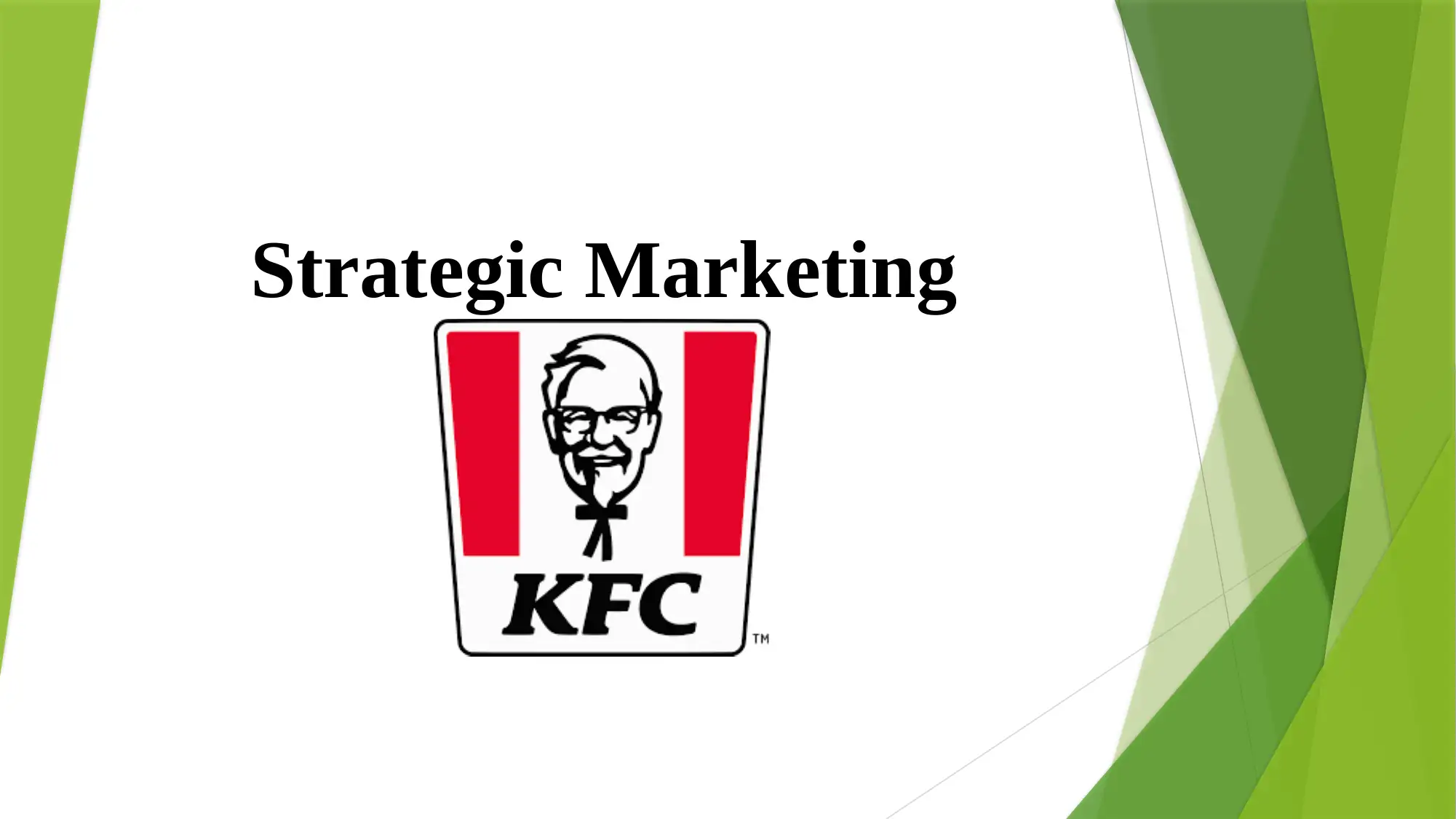
Strategic Marketing
Secure Best Marks with AI Grader
Need help grading? Try our AI Grader for instant feedback on your assignments.
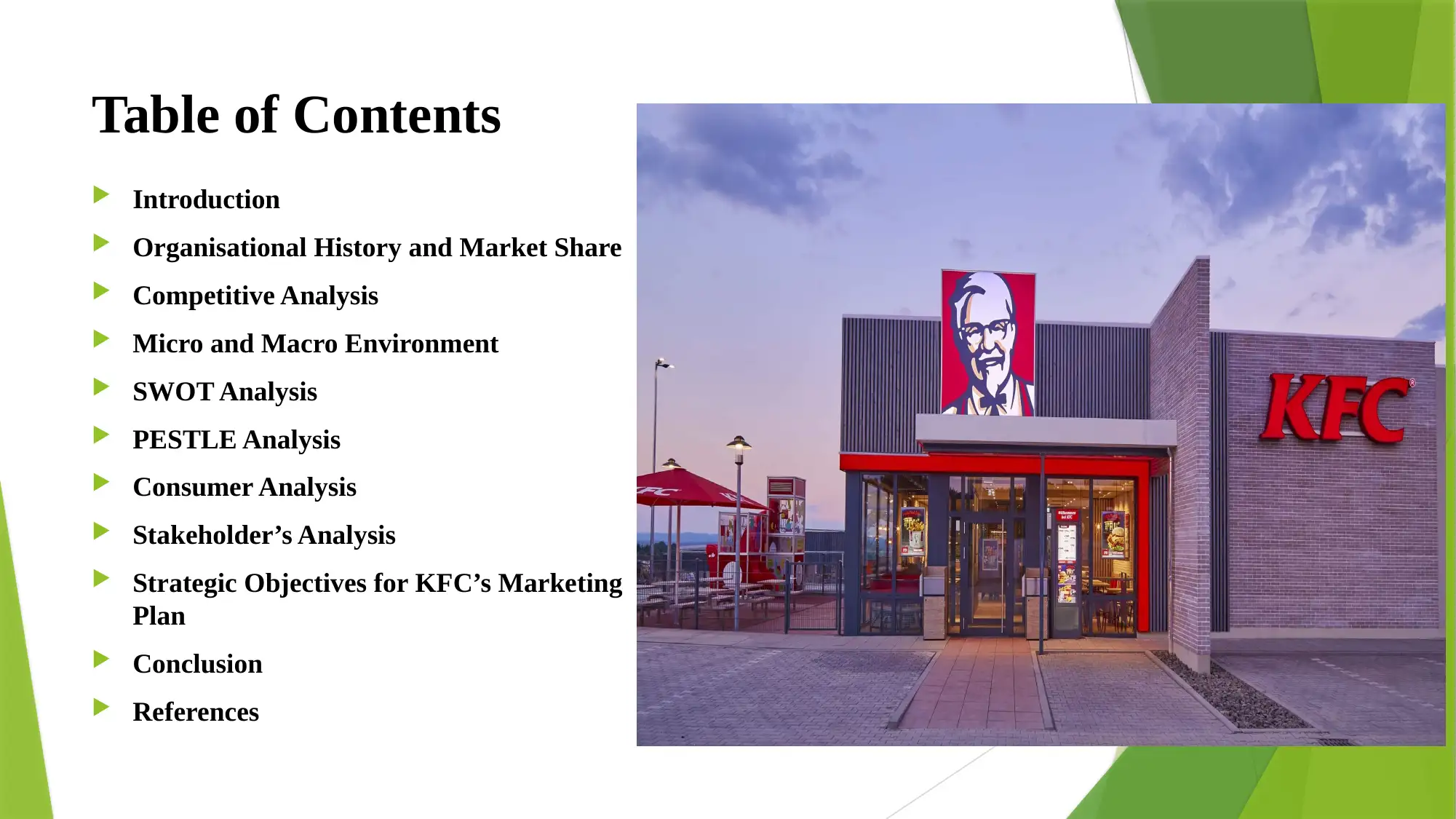
Table of Contents
Introduction
Organisational History and Market Share
Competitive Analysis
Micro and Macro Environment
SWOT Analysis
PESTLE Analysis
Consumer Analysis
Stakeholder’s Analysis
Strategic Objectives for KFC’s Marketing
Plan
Conclusion
References
Introduction
Organisational History and Market Share
Competitive Analysis
Micro and Macro Environment
SWOT Analysis
PESTLE Analysis
Consumer Analysis
Stakeholder’s Analysis
Strategic Objectives for KFC’s Marketing
Plan
Conclusion
References
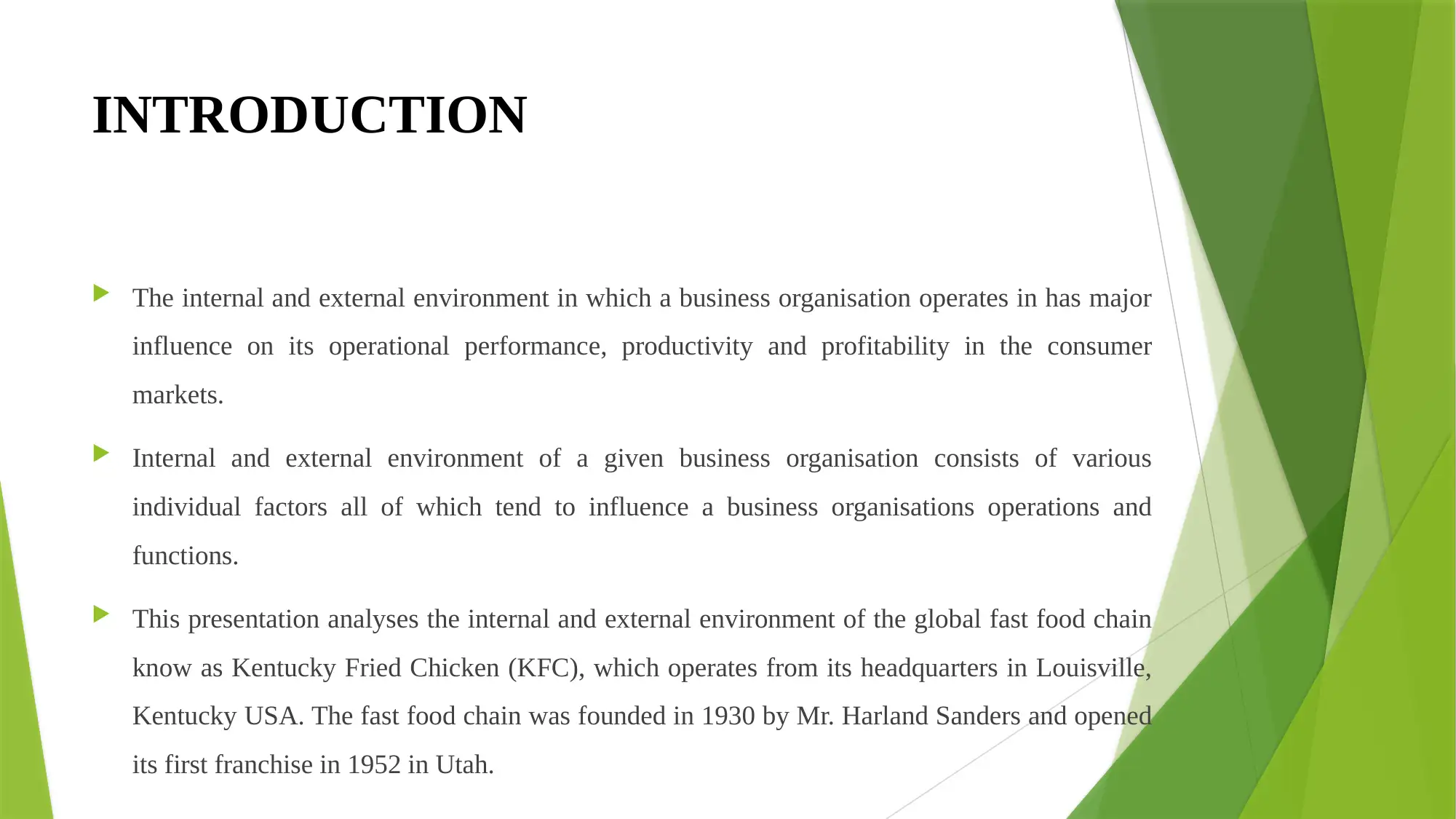
INTRODUCTION
The internal and external environment in which a business organisation operates in has major
influence on its operational performance, productivity and profitability in the consumer
markets.
Internal and external environment of a given business organisation consists of various
individual factors all of which tend to influence a business organisations operations and
functions.
This presentation analyses the internal and external environment of the global fast food chain
know as Kentucky Fried Chicken (KFC), which operates from its headquarters in Louisville,
Kentucky USA. The fast food chain was founded in 1930 by Mr. Harland Sanders and opened
its first franchise in 1952 in Utah.
The internal and external environment in which a business organisation operates in has major
influence on its operational performance, productivity and profitability in the consumer
markets.
Internal and external environment of a given business organisation consists of various
individual factors all of which tend to influence a business organisations operations and
functions.
This presentation analyses the internal and external environment of the global fast food chain
know as Kentucky Fried Chicken (KFC), which operates from its headquarters in Louisville,
Kentucky USA. The fast food chain was founded in 1930 by Mr. Harland Sanders and opened
its first franchise in 1952 in Utah.
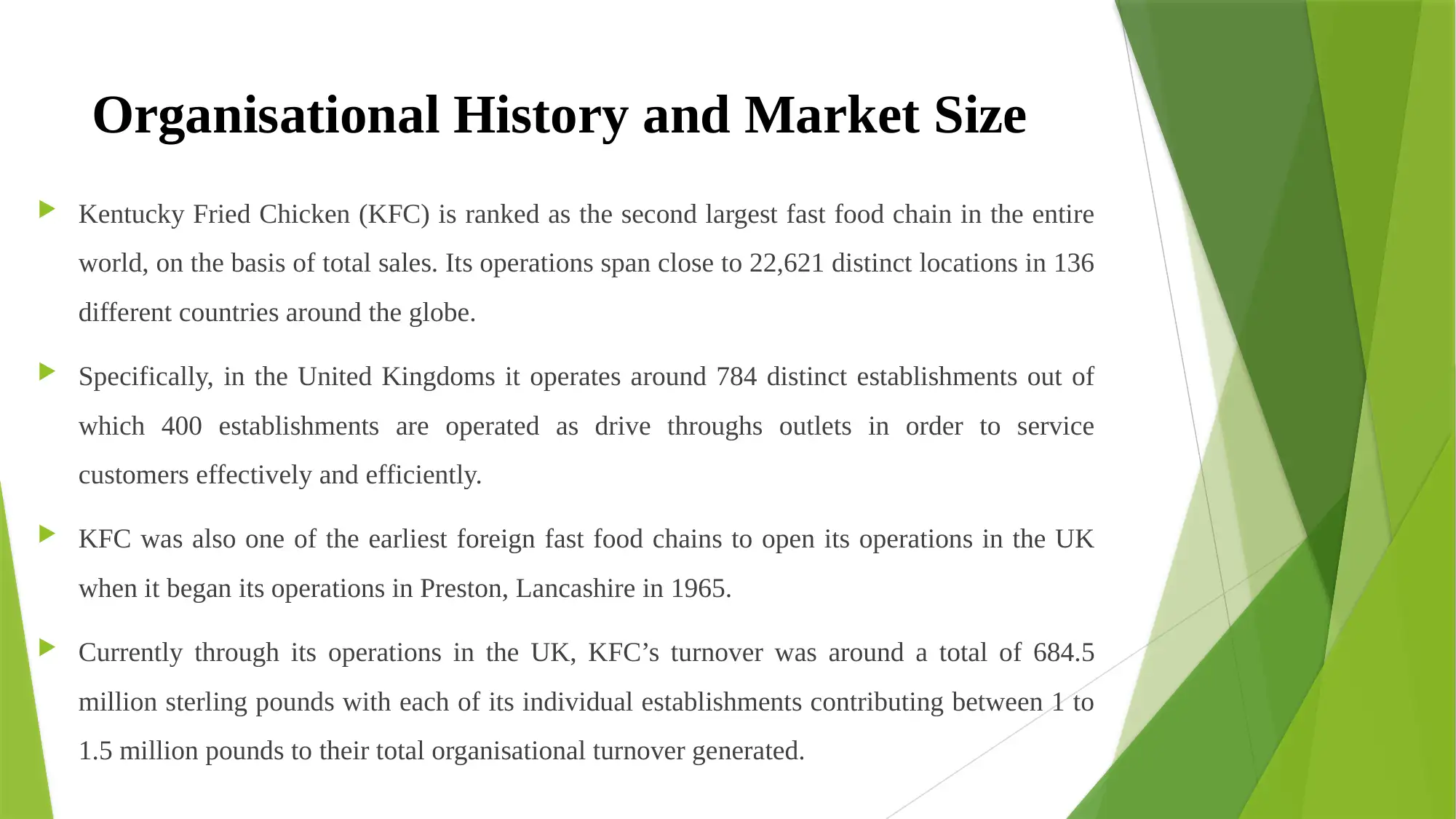
Organisational History and Market Size
Kentucky Fried Chicken (KFC) is ranked as the second largest fast food chain in the entire
world, on the basis of total sales. Its operations span close to 22,621 distinct locations in 136
different countries around the globe.
Specifically, in the United Kingdoms it operates around 784 distinct establishments out of
which 400 establishments are operated as drive throughs outlets in order to service
customers effectively and efficiently.
KFC was also one of the earliest foreign fast food chains to open its operations in the UK
when it began its operations in Preston, Lancashire in 1965.
Currently through its operations in the UK, KFC’s turnover was around a total of 684.5
million sterling pounds with each of its individual establishments contributing between 1 to
1.5 million pounds to their total organisational turnover generated.
Kentucky Fried Chicken (KFC) is ranked as the second largest fast food chain in the entire
world, on the basis of total sales. Its operations span close to 22,621 distinct locations in 136
different countries around the globe.
Specifically, in the United Kingdoms it operates around 784 distinct establishments out of
which 400 establishments are operated as drive throughs outlets in order to service
customers effectively and efficiently.
KFC was also one of the earliest foreign fast food chains to open its operations in the UK
when it began its operations in Preston, Lancashire in 1965.
Currently through its operations in the UK, KFC’s turnover was around a total of 684.5
million sterling pounds with each of its individual establishments contributing between 1 to
1.5 million pounds to their total organisational turnover generated.
Secure Best Marks with AI Grader
Need help grading? Try our AI Grader for instant feedback on your assignments.
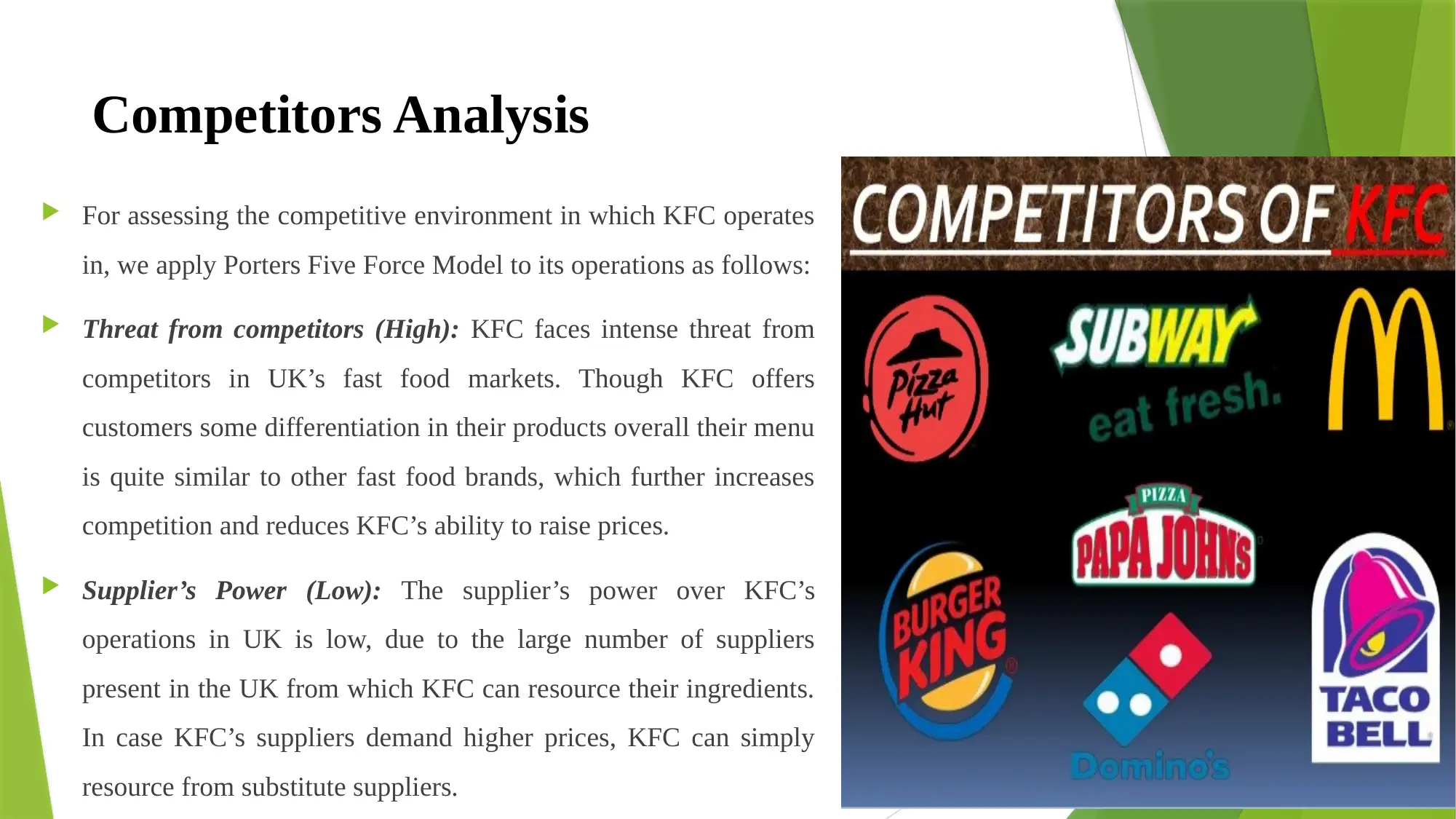
Competitors Analysis
For assessing the competitive environment in which KFC operates
in, we apply Porters Five Force Model to its operations as follows:
Threat from competitors (High): KFC faces intense threat from
competitors in UK’s fast food markets. Though KFC offers
customers some differentiation in their products overall their menu
is quite similar to other fast food brands, which further increases
competition and reduces KFC’s ability to raise prices.
Supplier’s Power (Low): The supplier’s power over KFC’s
operations in UK is low, due to the large number of suppliers
present in the UK from which KFC can resource their ingredients.
In case KFC’s suppliers demand higher prices, KFC can simply
resource from substitute suppliers.
For assessing the competitive environment in which KFC operates
in, we apply Porters Five Force Model to its operations as follows:
Threat from competitors (High): KFC faces intense threat from
competitors in UK’s fast food markets. Though KFC offers
customers some differentiation in their products overall their menu
is quite similar to other fast food brands, which further increases
competition and reduces KFC’s ability to raise prices.
Supplier’s Power (Low): The supplier’s power over KFC’s
operations in UK is low, due to the large number of suppliers
present in the UK from which KFC can resource their ingredients.
In case KFC’s suppliers demand higher prices, KFC can simply
resource from substitute suppliers.

CONT.
Threat from Substitutes (High): As competitors in the fast food industry of UK offer many products
that are similar to KFC’s menu dishes, it also faces high threat of substitutions for its operations. KFC
needs to offer higher differentiated products to consumers in an attempt to ward off threat from
substitutes.
Threat from New Entrants (Low): It is hard for new entrants to outcompete KFC, owing to their high
brand value and reputation in the fast food markets, loyal existing customer base and the high initial
costs of entering into fast food business related to operational, logistical and resourcing costs.
Buyer’s Power (High): Consumers possess high bargaining power in the fast food markets as the
industry is highly competitive and each brand competes to attract the highest customer base possible by
offering competitive prices. Consumers have numerous options available to them and all vie for their
attention.
Threat from Substitutes (High): As competitors in the fast food industry of UK offer many products
that are similar to KFC’s menu dishes, it also faces high threat of substitutions for its operations. KFC
needs to offer higher differentiated products to consumers in an attempt to ward off threat from
substitutes.
Threat from New Entrants (Low): It is hard for new entrants to outcompete KFC, owing to their high
brand value and reputation in the fast food markets, loyal existing customer base and the high initial
costs of entering into fast food business related to operational, logistical and resourcing costs.
Buyer’s Power (High): Consumers possess high bargaining power in the fast food markets as the
industry is highly competitive and each brand competes to attract the highest customer base possible by
offering competitive prices. Consumers have numerous options available to them and all vie for their
attention.
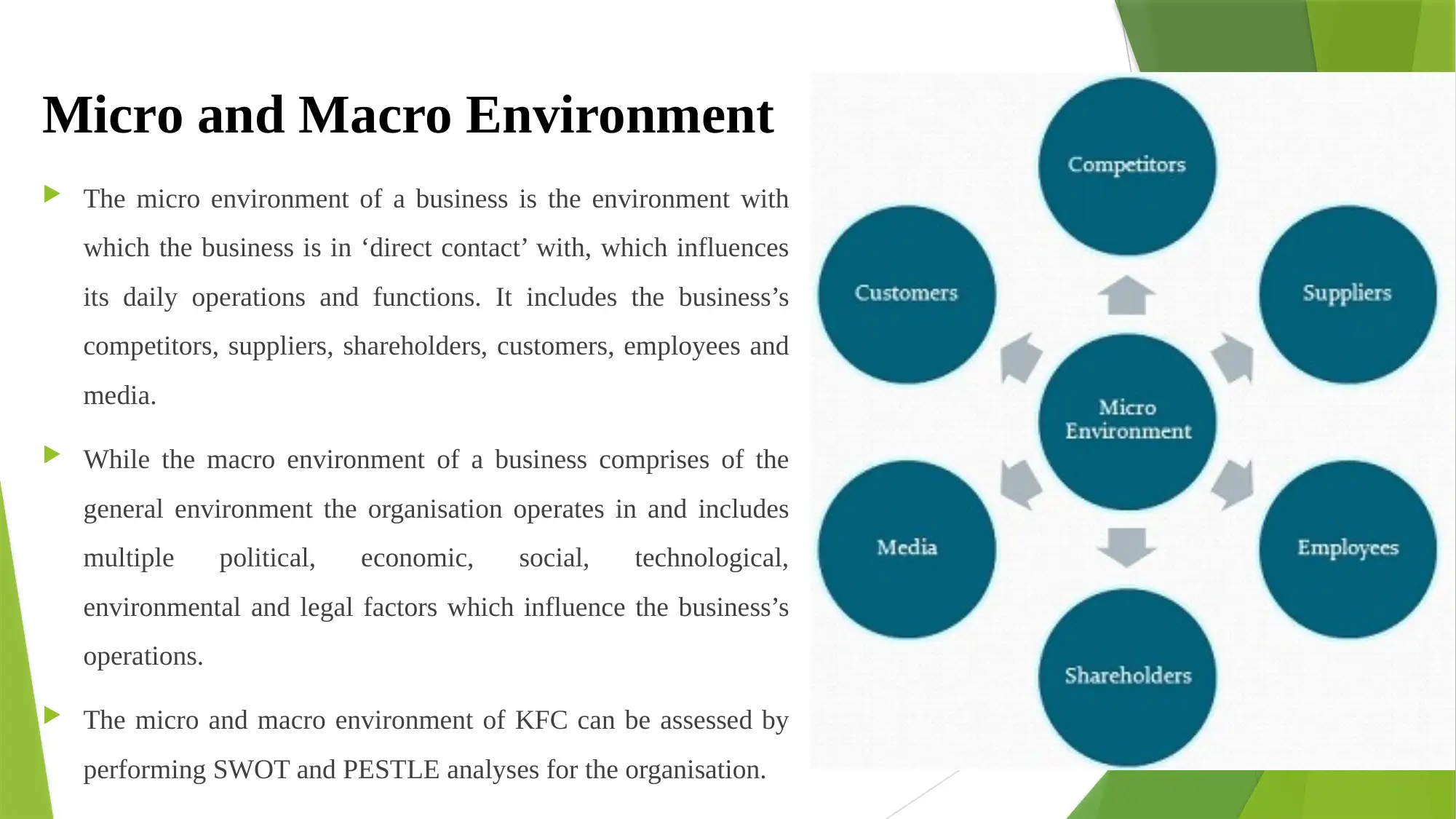
Micro and Macro Environment
The micro environment of a business is the environment with
which the business is in ‘direct contact’ with, which influences
its daily operations and functions. It includes the business’s
competitors, suppliers, shareholders, customers, employees and
media.
While the macro environment of a business comprises of the
general environment the organisation operates in and includes
multiple political, economic, social, technological,
environmental and legal factors which influence the business’s
operations.
The micro and macro environment of KFC can be assessed by
performing SWOT and PESTLE analyses for the organisation.
The micro environment of a business is the environment with
which the business is in ‘direct contact’ with, which influences
its daily operations and functions. It includes the business’s
competitors, suppliers, shareholders, customers, employees and
media.
While the macro environment of a business comprises of the
general environment the organisation operates in and includes
multiple political, economic, social, technological,
environmental and legal factors which influence the business’s
operations.
The micro and macro environment of KFC can be assessed by
performing SWOT and PESTLE analyses for the organisation.
Paraphrase This Document
Need a fresh take? Get an instant paraphrase of this document with our AI Paraphraser
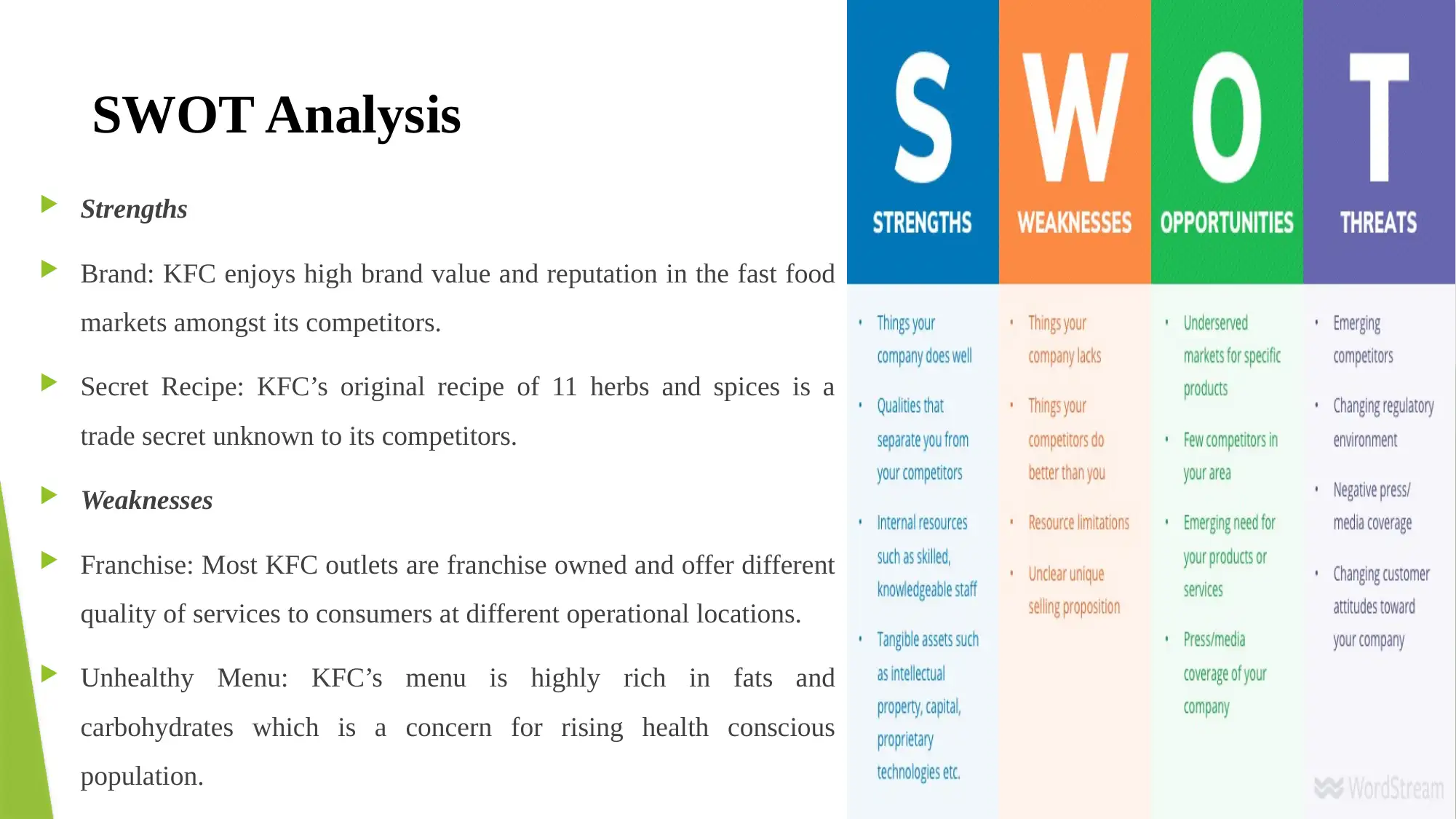
SWOT Analysis
Strengths
Brand: KFC enjoys high brand value and reputation in the fast food
markets amongst its competitors.
Secret Recipe: KFC’s original recipe of 11 herbs and spices is a
trade secret unknown to its competitors.
Weaknesses
Franchise: Most KFC outlets are franchise owned and offer different
quality of services to consumers at different operational locations.
Unhealthy Menu: KFC’s menu is highly rich in fats and
carbohydrates which is a concern for rising health conscious
population.
Strengths
Brand: KFC enjoys high brand value and reputation in the fast food
markets amongst its competitors.
Secret Recipe: KFC’s original recipe of 11 herbs and spices is a
trade secret unknown to its competitors.
Weaknesses
Franchise: Most KFC outlets are franchise owned and offer different
quality of services to consumers at different operational locations.
Unhealthy Menu: KFC’s menu is highly rich in fats and
carbohydrates which is a concern for rising health conscious
population.
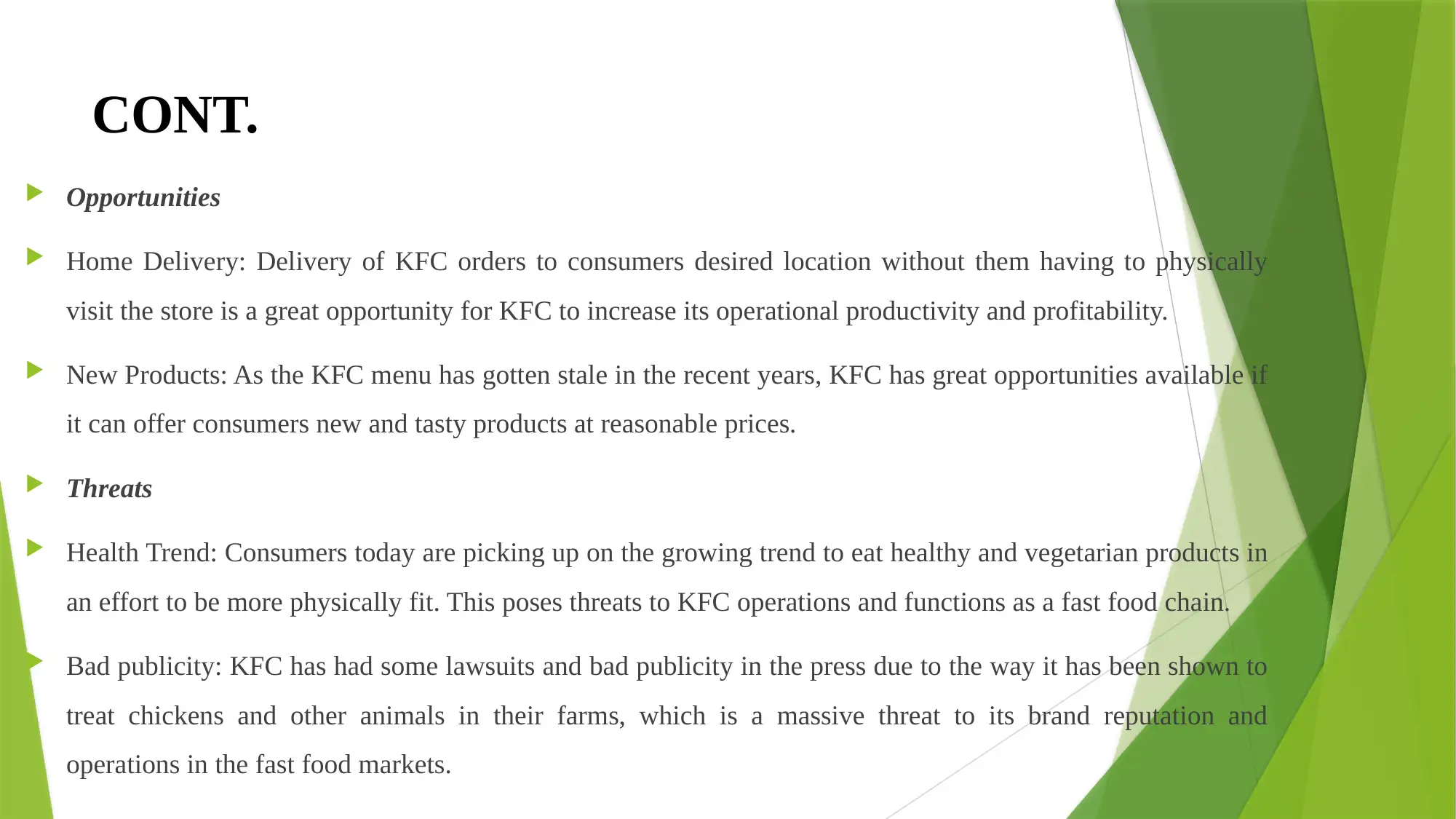
CONT.
Opportunities
Home Delivery: Delivery of KFC orders to consumers desired location without them having to physically
visit the store is a great opportunity for KFC to increase its operational productivity and profitability.
New Products: As the KFC menu has gotten stale in the recent years, KFC has great opportunities available if
it can offer consumers new and tasty products at reasonable prices.
Threats
Health Trend: Consumers today are picking up on the growing trend to eat healthy and vegetarian products in
an effort to be more physically fit. This poses threats to KFC operations and functions as a fast food chain.
Bad publicity: KFC has had some lawsuits and bad publicity in the press due to the way it has been shown to
treat chickens and other animals in their farms, which is a massive threat to its brand reputation and
operations in the fast food markets.
Opportunities
Home Delivery: Delivery of KFC orders to consumers desired location without them having to physically
visit the store is a great opportunity for KFC to increase its operational productivity and profitability.
New Products: As the KFC menu has gotten stale in the recent years, KFC has great opportunities available if
it can offer consumers new and tasty products at reasonable prices.
Threats
Health Trend: Consumers today are picking up on the growing trend to eat healthy and vegetarian products in
an effort to be more physically fit. This poses threats to KFC operations and functions as a fast food chain.
Bad publicity: KFC has had some lawsuits and bad publicity in the press due to the way it has been shown to
treat chickens and other animals in their farms, which is a massive threat to its brand reputation and
operations in the fast food markets.
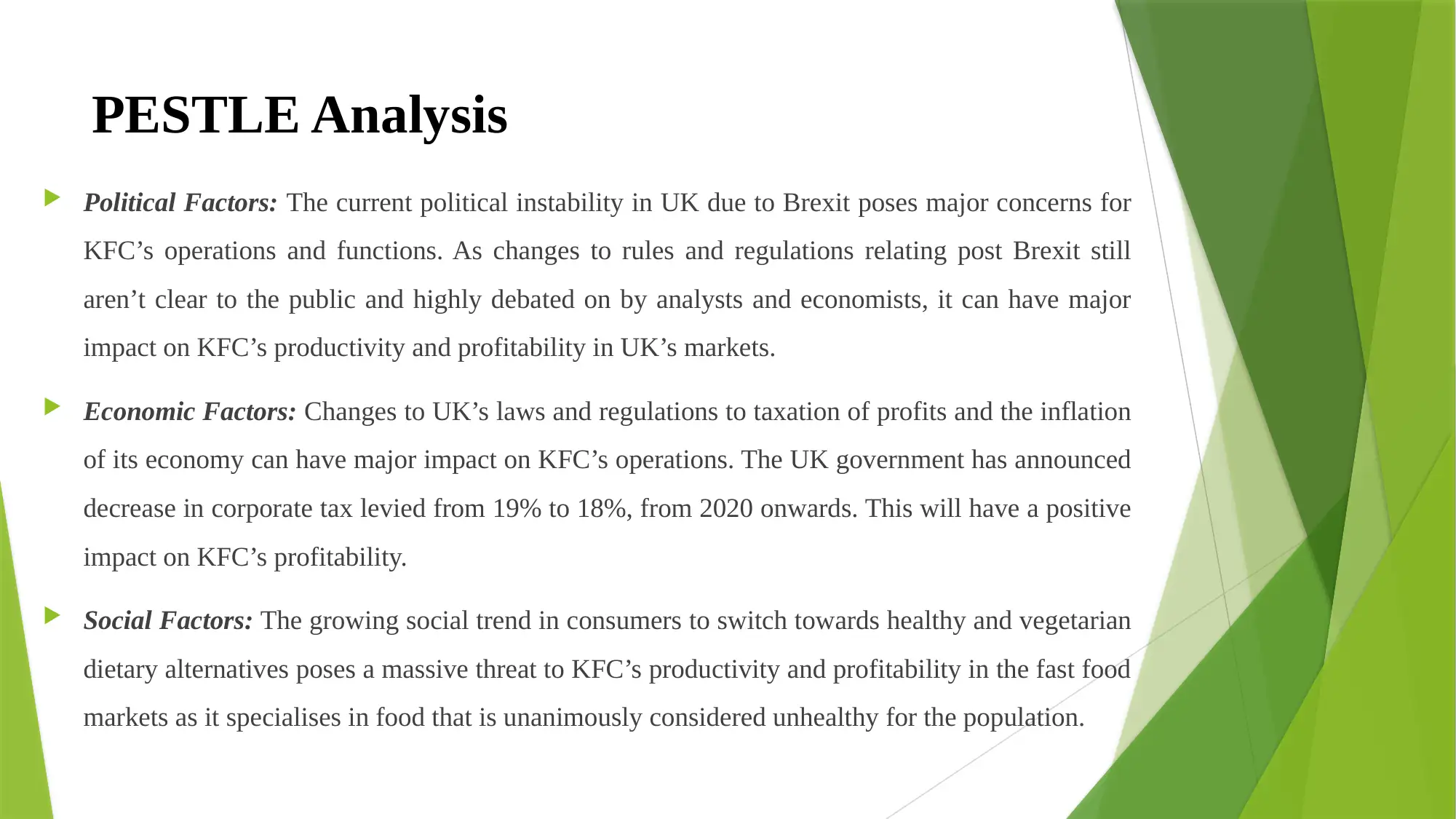
PESTLE Analysis
Political Factors: The current political instability in UK due to Brexit poses major concerns for
KFC’s operations and functions. As changes to rules and regulations relating post Brexit still
aren’t clear to the public and highly debated on by analysts and economists, it can have major
impact on KFC’s productivity and profitability in UK’s markets.
Economic Factors: Changes to UK’s laws and regulations to taxation of profits and the inflation
of its economy can have major impact on KFC’s operations. The UK government has announced
decrease in corporate tax levied from 19% to 18%, from 2020 onwards. This will have a positive
impact on KFC’s profitability.
Social Factors: The growing social trend in consumers to switch towards healthy and vegetarian
dietary alternatives poses a massive threat to KFC’s productivity and profitability in the fast food
markets as it specialises in food that is unanimously considered unhealthy for the population.
Political Factors: The current political instability in UK due to Brexit poses major concerns for
KFC’s operations and functions. As changes to rules and regulations relating post Brexit still
aren’t clear to the public and highly debated on by analysts and economists, it can have major
impact on KFC’s productivity and profitability in UK’s markets.
Economic Factors: Changes to UK’s laws and regulations to taxation of profits and the inflation
of its economy can have major impact on KFC’s operations. The UK government has announced
decrease in corporate tax levied from 19% to 18%, from 2020 onwards. This will have a positive
impact on KFC’s profitability.
Social Factors: The growing social trend in consumers to switch towards healthy and vegetarian
dietary alternatives poses a massive threat to KFC’s productivity and profitability in the fast food
markets as it specialises in food that is unanimously considered unhealthy for the population.
Secure Best Marks with AI Grader
Need help grading? Try our AI Grader for instant feedback on your assignments.
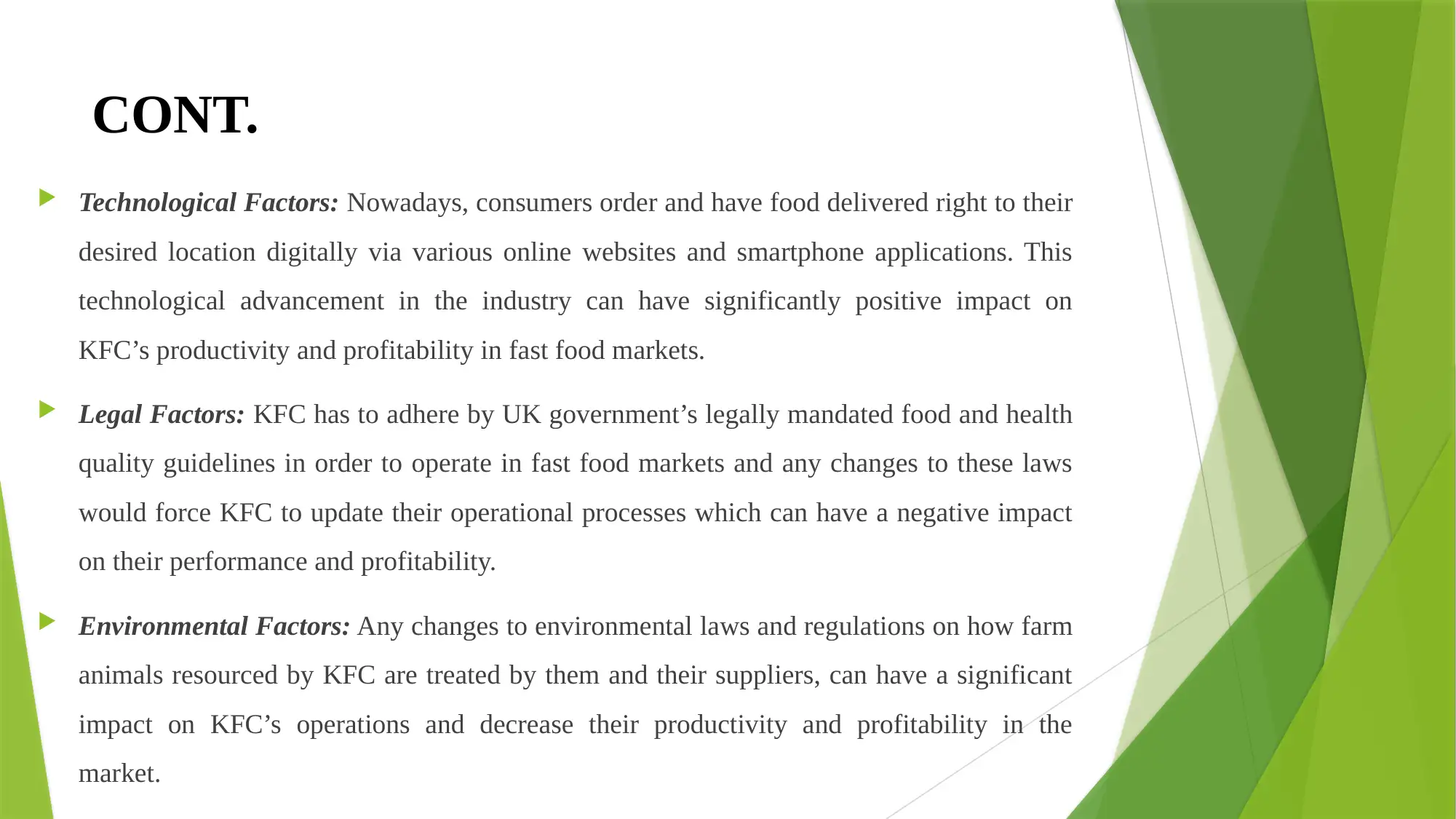
CONT.
Technological Factors: Nowadays, consumers order and have food delivered right to their
desired location digitally via various online websites and smartphone applications. This
technological advancement in the industry can have significantly positive impact on
KFC’s productivity and profitability in fast food markets.
Legal Factors: KFC has to adhere by UK government’s legally mandated food and health
quality guidelines in order to operate in fast food markets and any changes to these laws
would force KFC to update their operational processes which can have a negative impact
on their performance and profitability.
Environmental Factors: Any changes to environmental laws and regulations on how farm
animals resourced by KFC are treated by them and their suppliers, can have a significant
impact on KFC’s operations and decrease their productivity and profitability in the
market.
Technological Factors: Nowadays, consumers order and have food delivered right to their
desired location digitally via various online websites and smartphone applications. This
technological advancement in the industry can have significantly positive impact on
KFC’s productivity and profitability in fast food markets.
Legal Factors: KFC has to adhere by UK government’s legally mandated food and health
quality guidelines in order to operate in fast food markets and any changes to these laws
would force KFC to update their operational processes which can have a negative impact
on their performance and profitability.
Environmental Factors: Any changes to environmental laws and regulations on how farm
animals resourced by KFC are treated by them and their suppliers, can have a significant
impact on KFC’s operations and decrease their productivity and profitability in the
market.
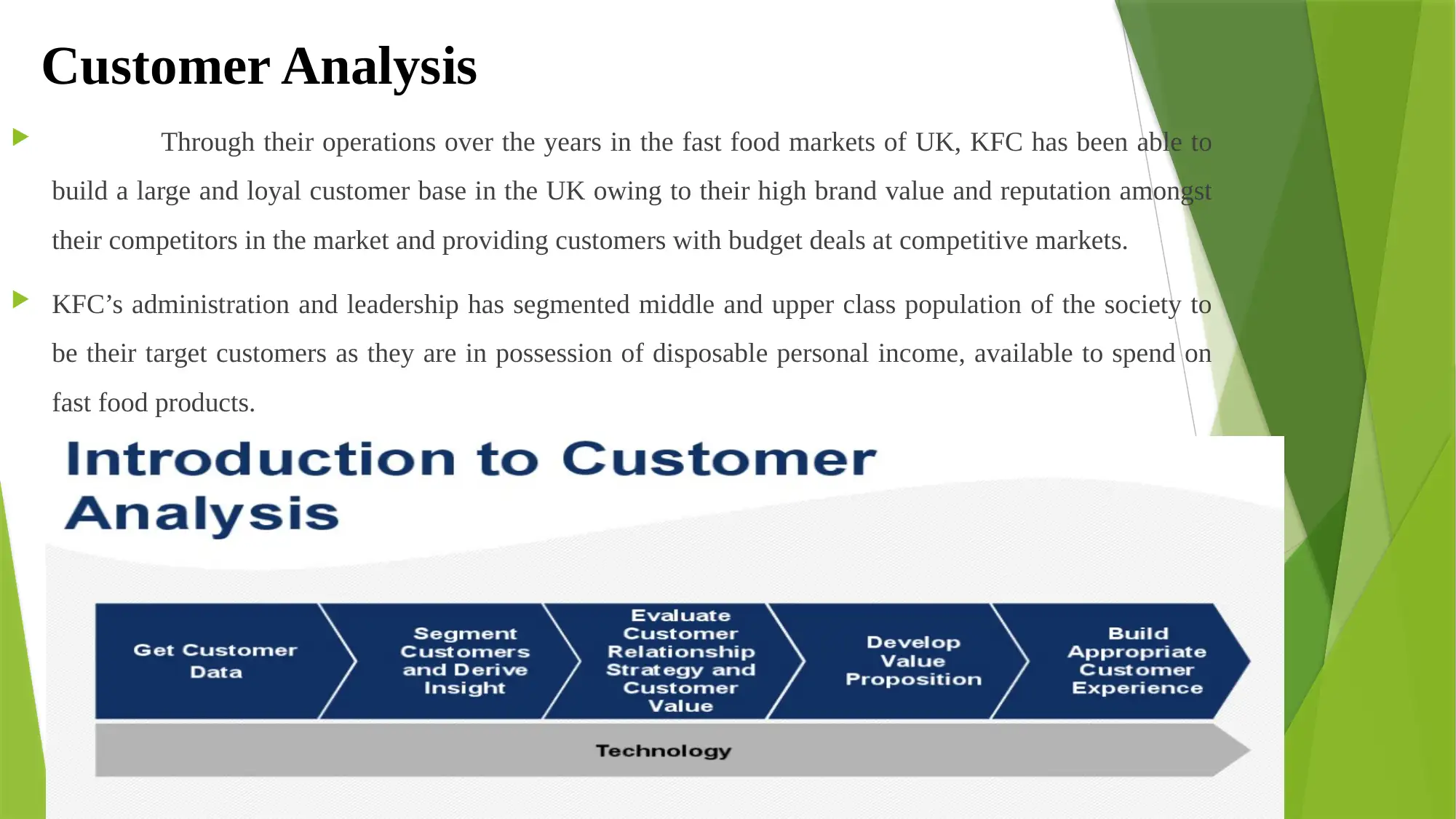
Customer Analysis
Through their operations over the years in the fast food markets of UK, KFC has been able to
build a large and loyal customer base in the UK owing to their high brand value and reputation amongst
their competitors in the market and providing customers with budget deals at competitive markets.
KFC’s administration and leadership has segmented middle and upper class population of the society to
be their target customers as they are in possession of disposable personal income, available to spend on
fast food products.
Through their operations over the years in the fast food markets of UK, KFC has been able to
build a large and loyal customer base in the UK owing to their high brand value and reputation amongst
their competitors in the market and providing customers with budget deals at competitive markets.
KFC’s administration and leadership has segmented middle and upper class population of the society to
be their target customers as they are in possession of disposable personal income, available to spend on
fast food products.
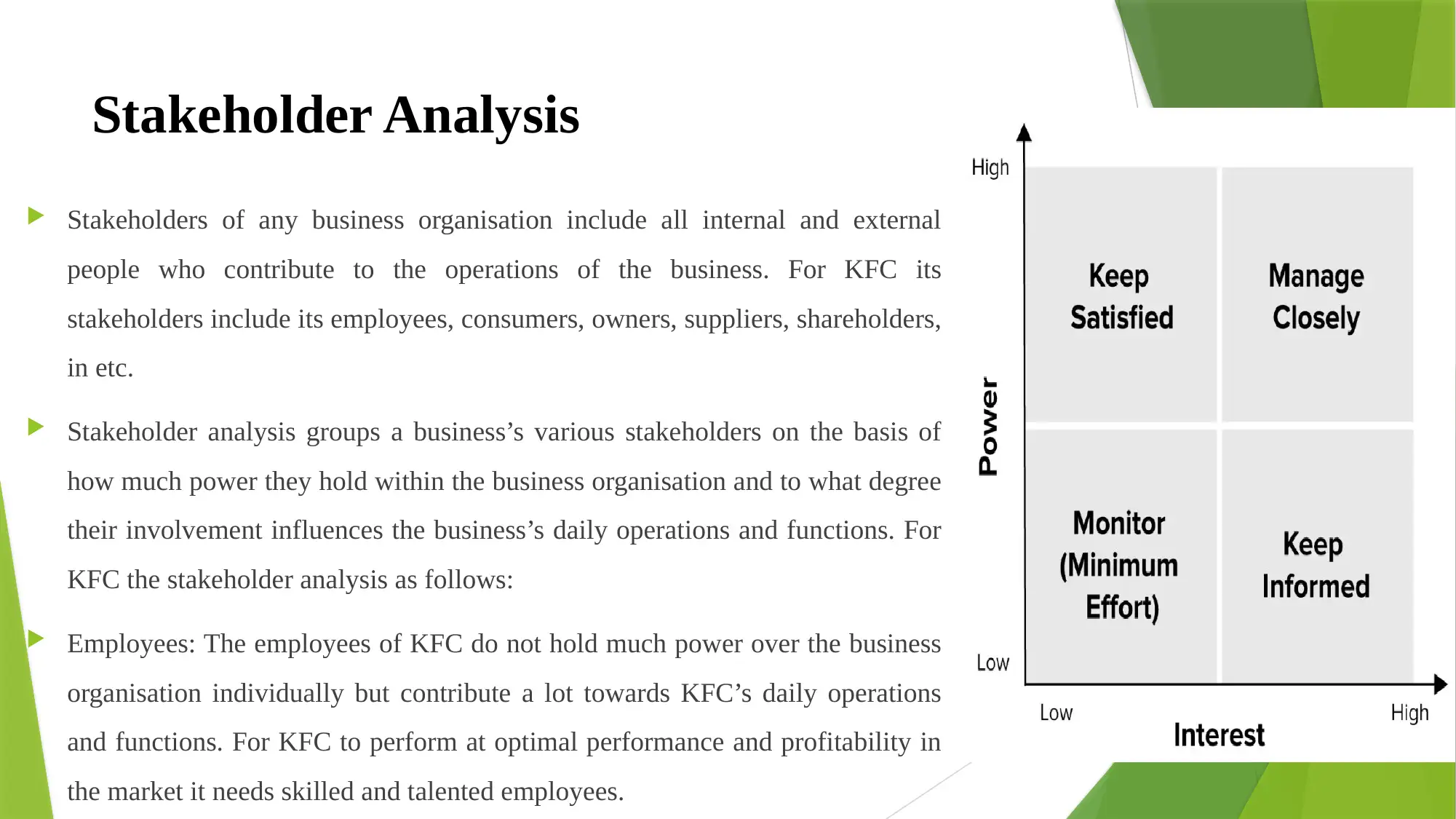
Stakeholder Analysis
Stakeholders of any business organisation include all internal and external
people who contribute to the operations of the business. For KFC its
stakeholders include its employees, consumers, owners, suppliers, shareholders,
in etc.
Stakeholder analysis groups a business’s various stakeholders on the basis of
how much power they hold within the business organisation and to what degree
their involvement influences the business’s daily operations and functions. For
KFC the stakeholder analysis as follows:
Employees: The employees of KFC do not hold much power over the business
organisation individually but contribute a lot towards KFC’s daily operations
and functions. For KFC to perform at optimal performance and profitability in
the market it needs skilled and talented employees.
Stakeholders of any business organisation include all internal and external
people who contribute to the operations of the business. For KFC its
stakeholders include its employees, consumers, owners, suppliers, shareholders,
in etc.
Stakeholder analysis groups a business’s various stakeholders on the basis of
how much power they hold within the business organisation and to what degree
their involvement influences the business’s daily operations and functions. For
KFC the stakeholder analysis as follows:
Employees: The employees of KFC do not hold much power over the business
organisation individually but contribute a lot towards KFC’s daily operations
and functions. For KFC to perform at optimal performance and profitability in
the market it needs skilled and talented employees.
Paraphrase This Document
Need a fresh take? Get an instant paraphrase of this document with our AI Paraphraser
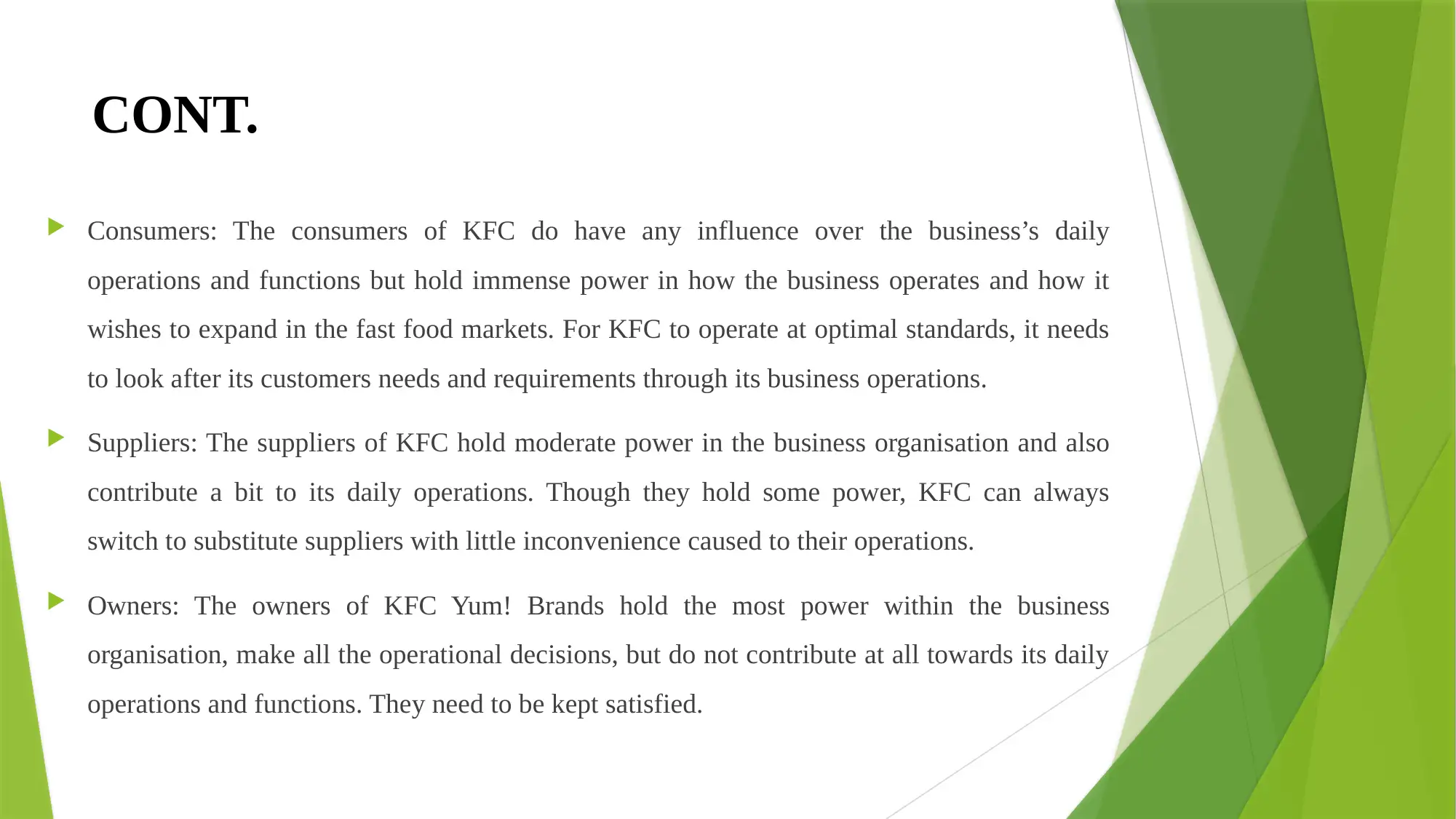
CONT.
Consumers: The consumers of KFC do have any influence over the business’s daily
operations and functions but hold immense power in how the business operates and how it
wishes to expand in the fast food markets. For KFC to operate at optimal standards, it needs
to look after its customers needs and requirements through its business operations.
Suppliers: The suppliers of KFC hold moderate power in the business organisation and also
contribute a bit to its daily operations. Though they hold some power, KFC can always
switch to substitute suppliers with little inconvenience caused to their operations.
Owners: The owners of KFC Yum! Brands hold the most power within the business
organisation, make all the operational decisions, but do not contribute at all towards its daily
operations and functions. They need to be kept satisfied.
Consumers: The consumers of KFC do have any influence over the business’s daily
operations and functions but hold immense power in how the business operates and how it
wishes to expand in the fast food markets. For KFC to operate at optimal standards, it needs
to look after its customers needs and requirements through its business operations.
Suppliers: The suppliers of KFC hold moderate power in the business organisation and also
contribute a bit to its daily operations. Though they hold some power, KFC can always
switch to substitute suppliers with little inconvenience caused to their operations.
Owners: The owners of KFC Yum! Brands hold the most power within the business
organisation, make all the operational decisions, but do not contribute at all towards its daily
operations and functions. They need to be kept satisfied.
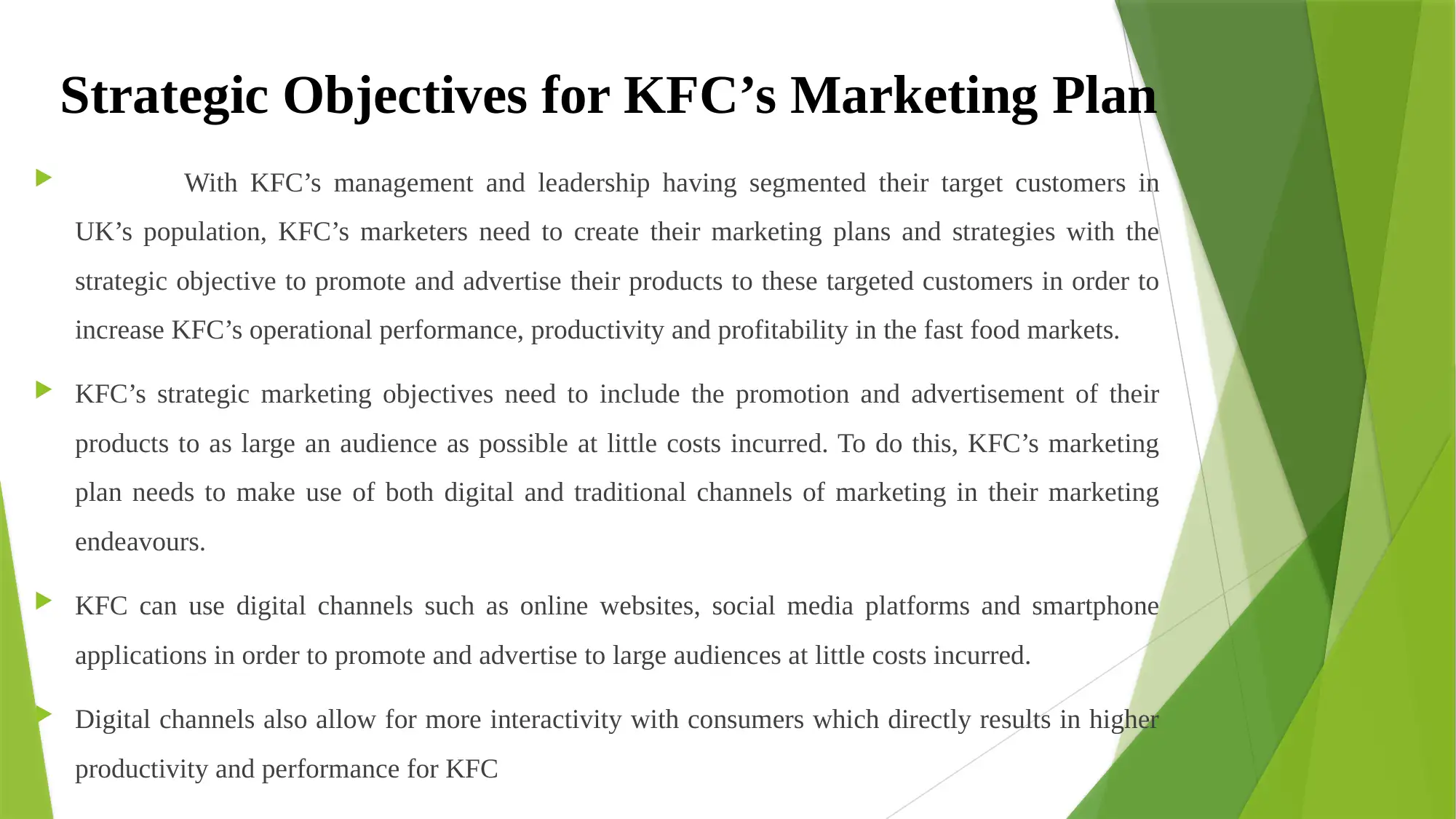
Strategic Objectives for KFC’s Marketing Plan
With KFC’s management and leadership having segmented their target customers in
UK’s population, KFC’s marketers need to create their marketing plans and strategies with the
strategic objective to promote and advertise their products to these targeted customers in order to
increase KFC’s operational performance, productivity and profitability in the fast food markets.
KFC’s strategic marketing objectives need to include the promotion and advertisement of their
products to as large an audience as possible at little costs incurred. To do this, KFC’s marketing
plan needs to make use of both digital and traditional channels of marketing in their marketing
endeavours.
KFC can use digital channels such as online websites, social media platforms and smartphone
applications in order to promote and advertise to large audiences at little costs incurred.
Digital channels also allow for more interactivity with consumers which directly results in higher
productivity and performance for KFC
With KFC’s management and leadership having segmented their target customers in
UK’s population, KFC’s marketers need to create their marketing plans and strategies with the
strategic objective to promote and advertise their products to these targeted customers in order to
increase KFC’s operational performance, productivity and profitability in the fast food markets.
KFC’s strategic marketing objectives need to include the promotion and advertisement of their
products to as large an audience as possible at little costs incurred. To do this, KFC’s marketing
plan needs to make use of both digital and traditional channels of marketing in their marketing
endeavours.
KFC can use digital channels such as online websites, social media platforms and smartphone
applications in order to promote and advertise to large audiences at little costs incurred.
Digital channels also allow for more interactivity with consumers which directly results in higher
productivity and performance for KFC
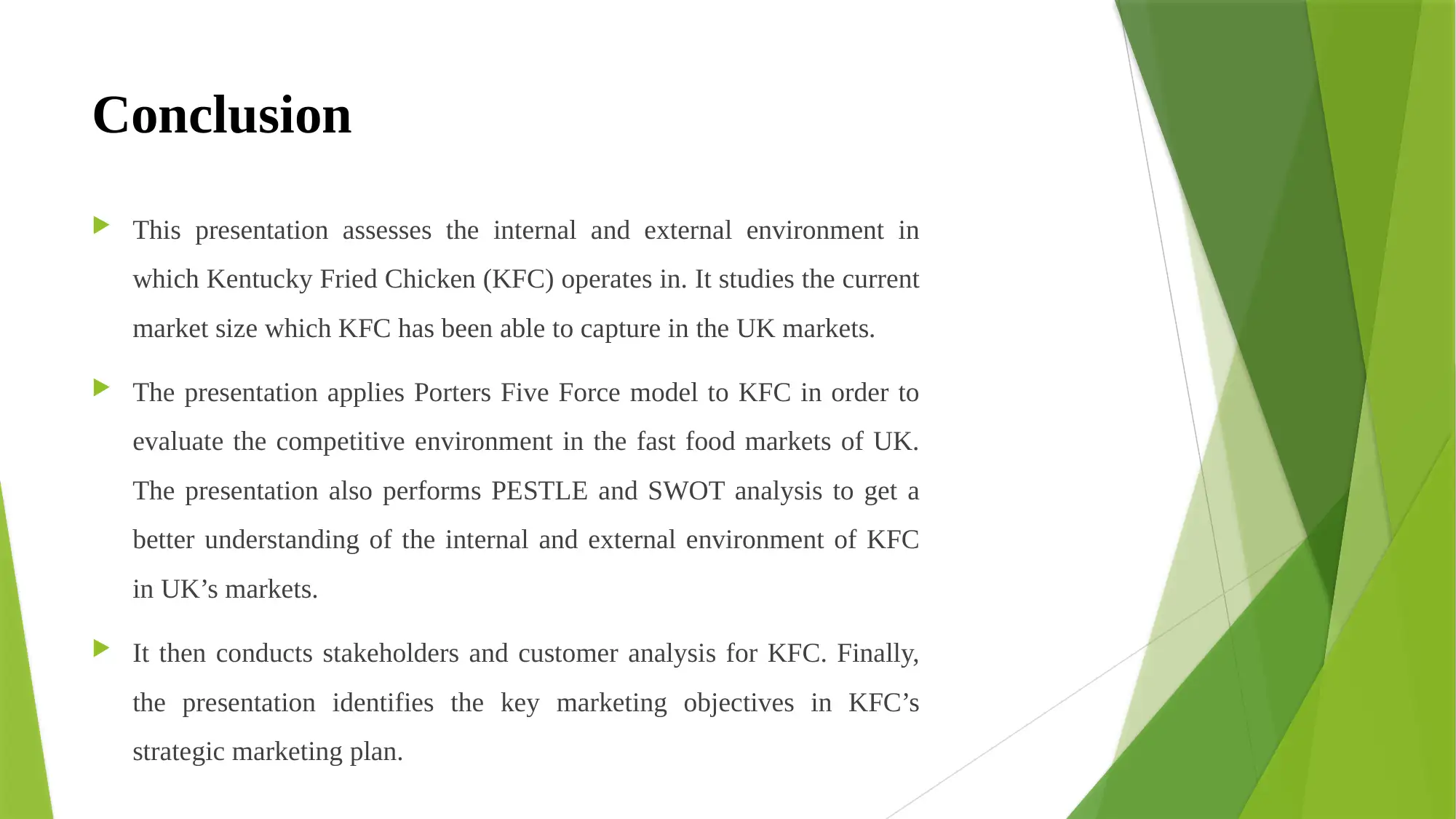
Conclusion
This presentation assesses the internal and external environment in
which Kentucky Fried Chicken (KFC) operates in. It studies the current
market size which KFC has been able to capture in the UK markets.
The presentation applies Porters Five Force model to KFC in order to
evaluate the competitive environment in the fast food markets of UK.
The presentation also performs PESTLE and SWOT analysis to get a
better understanding of the internal and external environment of KFC
in UK’s markets.
It then conducts stakeholders and customer analysis for KFC. Finally,
the presentation identifies the key marketing objectives in KFC’s
strategic marketing plan.
This presentation assesses the internal and external environment in
which Kentucky Fried Chicken (KFC) operates in. It studies the current
market size which KFC has been able to capture in the UK markets.
The presentation applies Porters Five Force model to KFC in order to
evaluate the competitive environment in the fast food markets of UK.
The presentation also performs PESTLE and SWOT analysis to get a
better understanding of the internal and external environment of KFC
in UK’s markets.
It then conducts stakeholders and customer analysis for KFC. Finally,
the presentation identifies the key marketing objectives in KFC’s
strategic marketing plan.
Secure Best Marks with AI Grader
Need help grading? Try our AI Grader for instant feedback on your assignments.
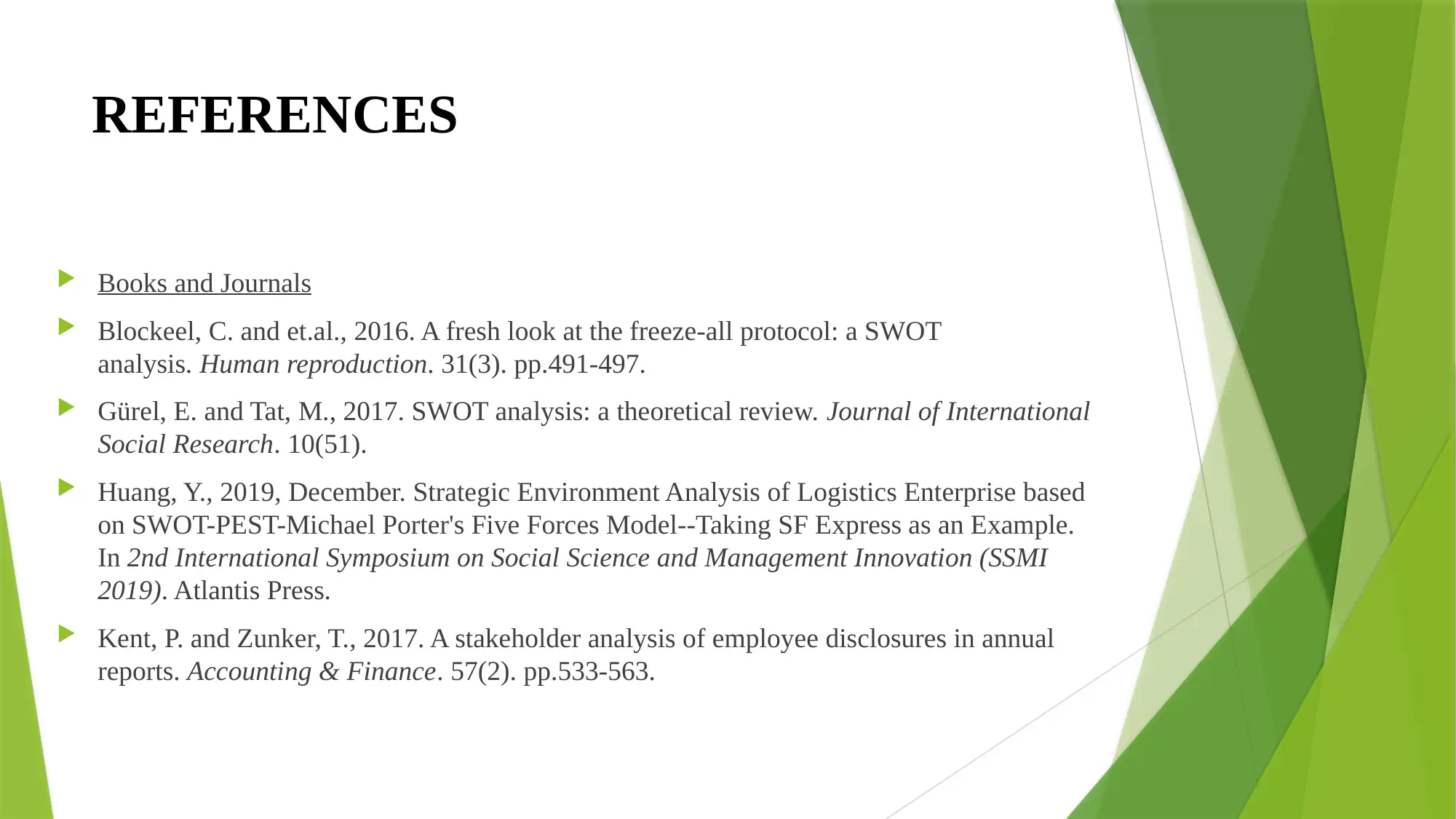
REFERENCES
Books and Journals
Blockeel, C. and et.al., 2016. A fresh look at the freeze-all protocol: a SWOT
analysis. Human reproduction. 31(3). pp.491-497.
Gürel, E. and Tat, M., 2017. SWOT analysis: a theoretical review. Journal of International
Social Research. 10(51).
Huang, Y., 2019, December. Strategic Environment Analysis of Logistics Enterprise based
on SWOT-PEST-Michael Porter's Five Forces Model--Taking SF Express as an Example.
In 2nd International Symposium on Social Science and Management Innovation (SSMI
2019). Atlantis Press.
Kent, P. and Zunker, T., 2017. A stakeholder analysis of employee disclosures in annual
reports. Accounting & Finance. 57(2). pp.533-563.
Books and Journals
Blockeel, C. and et.al., 2016. A fresh look at the freeze-all protocol: a SWOT
analysis. Human reproduction. 31(3). pp.491-497.
Gürel, E. and Tat, M., 2017. SWOT analysis: a theoretical review. Journal of International
Social Research. 10(51).
Huang, Y., 2019, December. Strategic Environment Analysis of Logistics Enterprise based
on SWOT-PEST-Michael Porter's Five Forces Model--Taking SF Express as an Example.
In 2nd International Symposium on Social Science and Management Innovation (SSMI
2019). Atlantis Press.
Kent, P. and Zunker, T., 2017. A stakeholder analysis of employee disclosures in annual
reports. Accounting & Finance. 57(2). pp.533-563.

1 out of 18
Related Documents
Your All-in-One AI-Powered Toolkit for Academic Success.
+13062052269
info@desklib.com
Available 24*7 on WhatsApp / Email
![[object Object]](/_next/static/media/star-bottom.7253800d.svg)
Unlock your academic potential
© 2024 | Zucol Services PVT LTD | All rights reserved.





